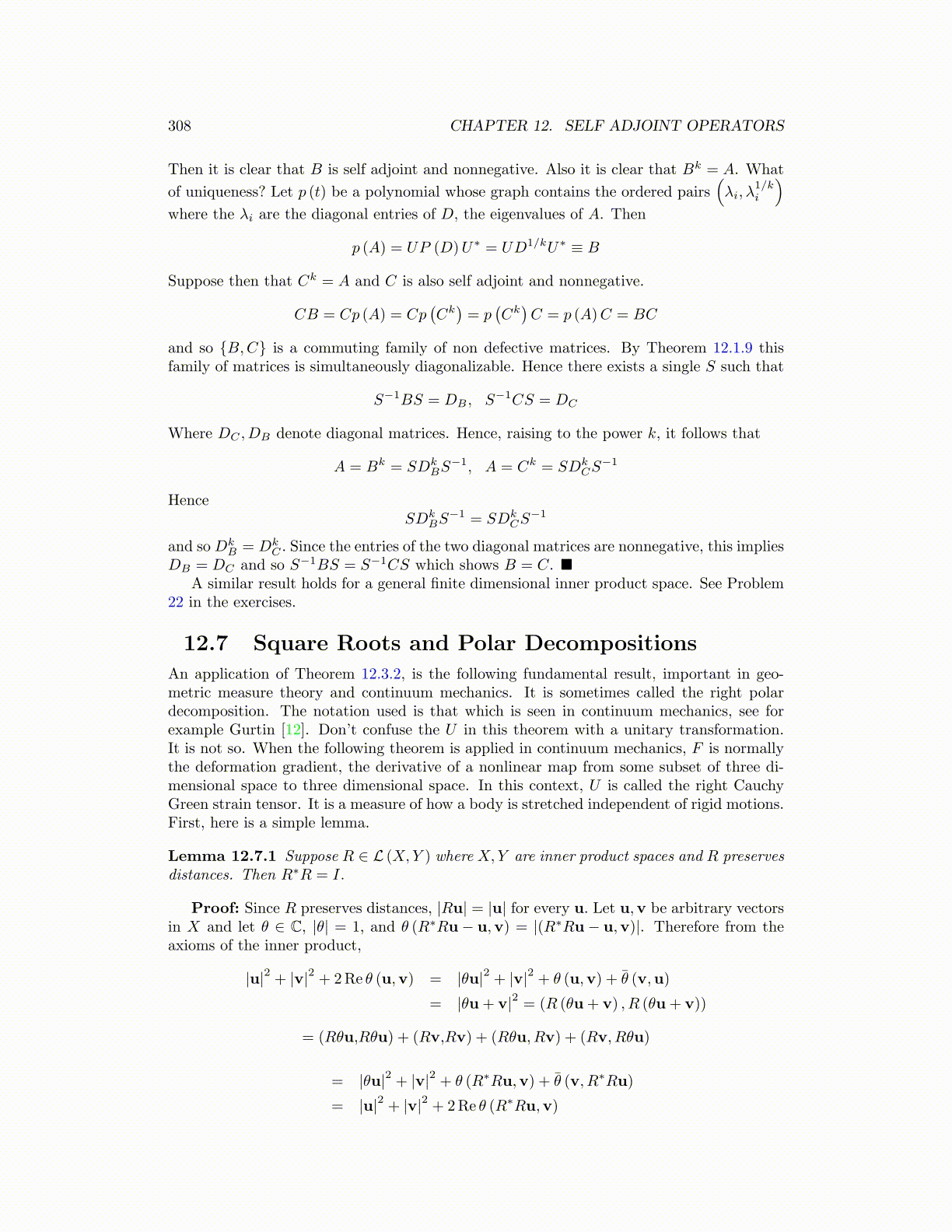
308 CHAPTER 12. SELF ADJOINT OPERATORS
Then it is clear that B is self adjoint and nonnegative. Also it is clear that Bk = A. What
of uniqueness? Let p (t) be a polynomial whose graph contains the ordered pairs(λi, λ
1/ki
)where the λi are the diagonal entries of D, the eigenvalues of A. Then
p (A) = UP (D)U∗ = UD1/kU∗ ≡ B
Suppose then that Ck = A and C is also self adjoint and nonnegative.
CB = Cp (A) = Cp(Ck)= p
(Ck)C = p (A)C = BC
and so {B,C} is a commuting family of non defective matrices. By Theorem 12.1.9 thisfamily of matrices is simultaneously diagonalizable. Hence there exists a single S such that
S−1BS = DB , S−1CS = DC
Where DC , DB denote diagonal matrices. Hence, raising to the power k, it follows that
A = Bk = SDkBS
−1, A = Ck = SDkCS
−1
HenceSDk
BS−1 = SDk
CS−1
and soDkB = Dk
C . Since the entries of the two diagonal matrices are nonnegative, this impliesDB = DC and so S−1BS = S−1CS which shows B = C. ■
A similar result holds for a general finite dimensional inner product space. See Problem22 in the exercises.
12.7 Square Roots and Polar Decompositions
An application of Theorem 12.3.2, is the following fundamental result, important in geo-metric measure theory and continuum mechanics. It is sometimes called the right polardecomposition. The notation used is that which is seen in continuum mechanics, see forexample Gurtin [12]. Don’t confuse the U in this theorem with a unitary transformation.It is not so. When the following theorem is applied in continuum mechanics, F is normallythe deformation gradient, the derivative of a nonlinear map from some subset of three di-mensional space to three dimensional space. In this context, U is called the right CauchyGreen strain tensor. It is a measure of how a body is stretched independent of rigid motions.First, here is a simple lemma.
Lemma 12.7.1 Suppose R ∈ L (X,Y ) where X,Y are inner product spaces and R preservesdistances. Then R∗R = I.
Proof: Since R preserves distances, |Ru| = |u| for every u. Let u,v be arbitrary vectorsin X and let θ ∈ C, |θ| = 1, and θ (R∗Ru− u,v) = |(R∗Ru− u,v)|. Therefore from theaxioms of the inner product,
|u|2 + |v|2 + 2Re θ (u,v) = |θu|2 + |v|2 + θ (u,v) + θ̄ (v,u)
= |θu+ v|2 = (R (θu+ v) , R (θu+ v))
= (Rθu,Rθu) + (Rv,Rv) + (Rθu, Rv) + (Rv, Rθu)
= |θu|2 + |v|2 + θ (R∗Ru,v) + θ̄ (v, R∗Ru)
= |u|2 + |v|2 + 2Re θ (R∗Ru,v)